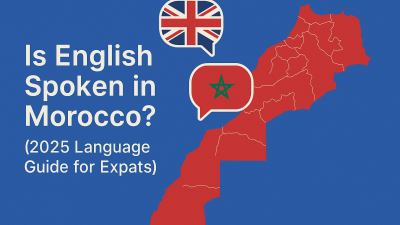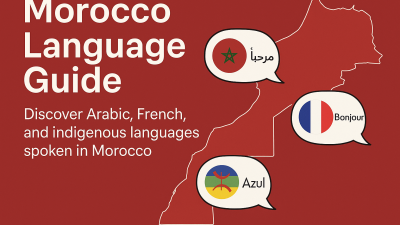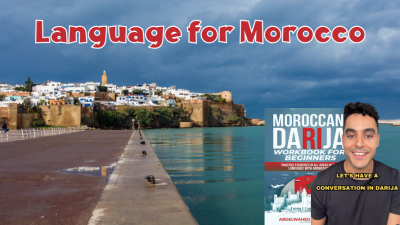When people ask about the language for Morocco or wonder what the Morocco national language is, most think immediately of Arabic. But Morocco is home to another ancient language that forms the very roots of its culture and identity: Amazigh. Also known as Berber, the Amazigh language has existed in North Africa for thousands of years and continues to play a central role in Moroccan life today.
In this article, we’ll explore the Amazigh language in Morocco—its history, varieties, cultural importance, and how it coexists with Arabic, French, and English. We’ll also look at the challenges and opportunities it faces in a rapidly modernizing society.
What Is the Amazigh Language?
The Amazigh language belongs to the Afro-Asiatic language family, which includes Arabic, Hebrew, and other Semitic languages. The word “Amazigh” means “free people” or “noble men”, and it reflects the deep connection Amazigh communities have to their land and traditions.
While many outsiders refer to it as “Berber,” most speakers prefer the term Amazigh or Tamazight, as it honors their own identity rather than a label given by others.
Amazigh as a Morocco National Language
Since the 2011 Moroccan Constitution, Amazigh has been officially recognized as one of the two Morocco national languages, alongside Arabic. This was a historic moment, as it gave Amazigh equal status in law, education, and public life.
Today, Amazigh is taught in schools, included on road signs, and even printed on Moroccan banknotes using the Tifinagh alphabet—a unique script that dates back centuries.
This recognition has strengthened Morocco’s multilingual identity, showing that the Morocco language is not one but a blend of Arabic, Amazigh, and other influences.
Varieties of Amazigh in Morocco
The Amazigh language is not a single dialect, but rather a group of related dialects spoken in different regions:
- Tarifit (Riffian): spoken in the Rif Mountains of northern Morocco.
- Tamazight (Central Atlas): used in the Middle Atlas Mountains.
- Tachelhit (Shilha): widespread in the High Atlas, Anti-Atlas, and Souss Valley.
Although these dialects differ, they share a common root and can be unified through the Tifinagh script and modern standardization efforts.
Amazigh in Daily Moroccan Life
If you travel through Morocco, you’ll notice the Amazigh language everywhere:
- In rural villages where elders speak Amazigh as their first language.
- In popular Moroccan music and festivals, where Amazigh songs carry history and tradition.
- In crafts, jewelry, and carpets, where symbols often represent Amazigh heritage.
- On TV and radio, where Amazigh channels broadcast news and cultural programs.
For many Moroccans, Amazigh is not just a language—it’s a way of life tied to hospitality, oral traditions, and strong community bonds.
The Tifinagh Alphabet
One of the most unique aspects of Amazigh is its Tifinagh alphabet, a set of geometric symbols that have been used for centuries. In 2003, Morocco officially adopted a modernized version of Tifinagh for education and media.
Today, you can see Tifinagh on public signs, government buildings, and Moroccan money, standing proudly next to Arabic and French.
This visual presence is a symbol of recognition and pride for Amazigh communities.
The Role of Arabic, French, and English
While Amazigh is a national language, Morocco remains a multilingual society:
- Darija (Moroccan Arabic): the main spoken language in cities and markets.
- Classical Arabic: used in schools, religion, and official documents.
- French: strong in administration, business, and education.
- English: rapidly growing as Morocco opens more to global trade and youth culture.
This mix makes Morocco unique, but it also means that Amazigh speakers often need to switch between several languages daily.
Challenges Facing the Amazigh Language
Despite official recognition, the Amazigh language still faces challenges:
- Implementation in schools: Not all schools have Amazigh teachers or resources.
- Urban dominance of Arabic and French: In big cities, many young people speak little Amazigh.
- Digital presence: While Arabic and French dominate online, Amazigh content is limited.
- Standardization issues: The three major dialects are not always mutually understood.
Still, there is strong progress. Civil society organizations, government programs, and cultural activists are working to preserve and expand Amazigh use.
Learning Amazigh as a Foreigner
For expats or tourists, learning Amazigh can be a fascinating way to connect with Moroccan culture. While most Moroccans will switch to Darija, French, or even English, speaking a few Amazigh words often earns deep respect.
Examples:
- Azul – Hello
- Tanemmirt – Thank you
- Amek ti d-tgit? – How are you?
Like Moroccan Arabic (Darija), Amazigh can be challenging for learners, but the cultural rewards are immense.
Abdelwahed Tabaallout and Language Learning
While his main focus is on teaching Darija, Moroccan educator Abdelwahed Tabaallout also highlights the importance of multilingualism in Morocco, including the Amazigh dimension. Through his platform Daily Darija and his Moroccan Darija Workbook for Beginners, he helps learners grasp the complex reality of the Morocco language.
His work shows that to truly understand Morocco, one must go beyond Arabic and explore Amazigh culture too.
Why Amazigh Matters Today
The Amazigh language is more than a tool of communication—it is:
- A cultural anchor for millions of Moroccans.
- A symbol of diversity and coexistence in Morocco.
- A bridge to history, linking modern society to its deep North African roots.
For Morocco, keeping Amazigh alive means preserving identity while embracing modernity.
FAQs About Amazigh Language in Morocco
1. Is Amazigh an official Morocco national language?
Yes, since 2011, Amazigh is recognized alongside Arabic as a national language.
2. How many people speak Amazigh in Morocco?
Around 30–40% of the population speaks one of its dialects.
3. What script is used to write Amazigh?
The Tifinagh alphabet, officially adopted in Morocco in 2003.
4. Is Amazigh related to Arabic?
They share the Afro-Asiatic language family but are distinct languages.
5. Should expats learn Amazigh or Darija?
Darija is more practical for daily life, but learning Amazigh shows cultural respect.
Conclusion
The Amazigh language in Morocco is a living symbol of history, identity, and resilience. Recognized today as a Morocco national language, it stands proudly alongside Arabic, shaping the diverse language for Morocco.
For visitors, expats, and learners, embracing Amazigh opens a window into Morocco’s soul. Whether through everyday words, cultural traditions, or teachers like Abdelwahed Tabaallout, the Amazigh language remains a key to understanding the Moroccan way of life.


